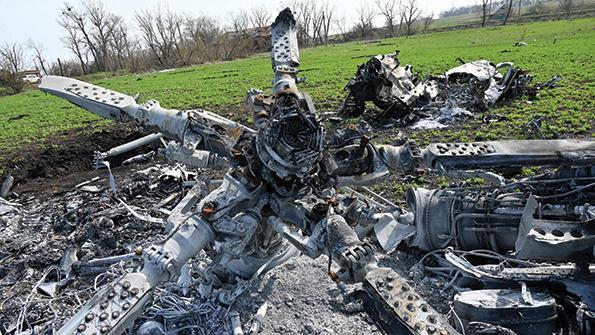
The wreckage of a downed Russian helicopter lies in a Ukraine field.
LONDON—Lessons around basing, munitions, and uncrewed aircraft systems are emerging from the Russia-Ukraine war that European air forces should take heed of, a new report from a London-based think tank suggests.
The Russian invasion of Ukraine has confirmed the threat posed from long-range fires such as ballistic and cruise missiles, as well as the urgent need for enlarged stockpiles of weapons.
In an examination of the conflict produced by the Royal United Services Institute (RUSI), researchers found that only dispersal of the Ukrainian Air Force’s fighter assets ensured that they could maintain operations.
“Despite the technical overmatch of the VKS (Russian Air Force), the training conducted by the air force prior to 24 February played a role in ensuring its survivability,” says the report, written by British and Ukrainian researchers Mykhaylo Zabrodskyi, Jack Watling, Oleksandr Danylyuk and Nick Reynolds. Special attention, they said, was paid to the training of maintenance crews to carry out preparation of the aircraft in field conditions.
These efforts were necessary. In the first days of the war, Russia undertook a massive missile campaign against Ukrainian air defense command-and-control infrastructure, airfields and ammunition depots, but they failed to follow up with bomb damage assessments.
“The Russian military appears to have presumed that if an action had been ordered and carried out then it had succeeded, unless there was direct evidence to the contrary,” the report says.
These issues subsequently made the Russian military highly vulnerable to deception, resulting in considerable wasting of ammunition and “a presumption of success” which prompted them to take “unjustifiable risks,” including aircraft not flying with electronic warfare pods and equipment.
The Russian long-range strikes, RUSI states, mean that there is “no sanctuary in modern warfare” and that “survivability depends on dispersing ammunitions stocks, command and control, maintenance areas and aircraft.”
This, the researchers say, prompts questions about how well dispersed European air forces can be, given shortfalls in deployable spares packs and the increasing reliance of modern aircraft on software.
Munition stocks are another concern, and while the report has focused particularly on supplies of artillery shells, it notes that no other country in NATO, apart from the U.S., has sufficient initial weapons stocks for warfighting or the industrial capacity to sustain large-scale operations. This must be rectified, the report says, if deterrence is to be credible.
“Resilience demands a capacity to build new units, produce spare parts and ammunition, and have sufficient stockpiles to remain competitive in the opening phases of fighting,” the authors state.
“At present, it is evident that NATO members other than the U.S. are not in a strong position on these fronts,” they say.
The report also prompts questions around the use of uncrewed aircraft systems (UAS) after RUSI found that attrition levels were high. Indeed, as much as 90% of the Ukrainian Armed Forces UAS inventory was destroyed in the first months of the war, including the Turkish-made Bayraktar TB2 tactical UAS. The average life expectancy for a multicopter UAS was roughly three flights, while a fixed-wing system might survive around six flights. Skilled crews who would preprogram the flightpaths of the UAS’ to use terrain masking could extend the life of their platforms. The report suggests use of the TB2s, for example, was shifted toward armed intelligence, surveillance and reconnaissance of coastal areas, where they had success against Russian fast-attack craft.
RUSI urges nations to heed lessons from the conflict, particularly around resilience and munition stocks. As Ukraine expends significant ammunition stocks to push back the Russians, they are now largely dependent on Western allies for equipment.
“It is important that those partners draw the appropriate lessons from the war so far, not least so that they can prepare themselves to deter future threats and to best support Ukraine,” the report concludes.

Comments